Rustico Bay (Sept. 11)
The drive from our campground outside Fredericton to our campground on Rustico Bay, PEI was supposed to be 3 hours, but took much longer. The part in New Brunswick was very scenic – looking a lot like northern Ontario or Maine, with rolling hills covered with forest, lots of rock outcroppings, and plenty of moose country (but no moose to be seen).
Until 1997, going to Prince Edward Island (PEI) required a ferry ride. In 1997 the Confederation Bridge was completed, linking PEI to the mainland across the strait – a very long expanse of water. The bridge is only 1 lane in each direction, and has only concrete traffic barriers between the right side of the land and the water. In short, it is a slightly nerve-wracking journey. When the weather is bad enough, especially when it is windy, the bridge is closed. Just before the bridge is a sign giving the speed limit for the day, which depends on the wind. Although it was a very gusty day, there was no reduction in speed when we crossed. However, I can tell you that we felt every gust and we reduced our speed accordingly. I took photos on the return trip.
On PEI, most of the roads are still country lanes – in fact, some of them are gravel. As well, the island is quite hilly. As a result, travel was slower than Google maps led us to believe – nothing really difficult, but nothing you would want to rush with the RV.
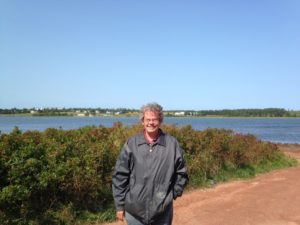
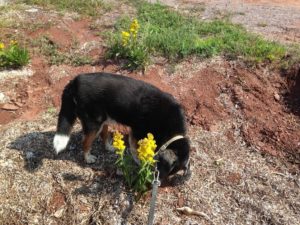 The campground was basically an open field, but it was right across the road from Rustico Bay, the owners were friendly, and with few campers, much of the field was available for Rumple’s amusement. As in Cape Cod, it was mushroom season, with lots of big mushrooms popping up everywhere.
The campground was basically an open field, but it was right across the road from Rustico Bay, the owners were friendly, and with few campers, much of the field was available for Rumple’s amusement. As in Cape Cod, it was mushroom season, with lots of big mushrooms popping up everywhere.
Before I arrived in PEI, there were only 3 things I knew about it: potatoes are the main crop, the soil is red and it is the setting for “Anne of Green Gables”.
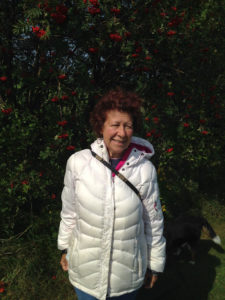
Most of PEI is agricultural, with potatoes as the main crop and a few cows, horses and even alpacas. The fields are separated by hedgerows, which are filled with wild apple trees and showy mountain ash. “Showy” is part of the name to distinguish this tree from another native species of mountain ash which has fewer berries.
PEI looks a lot like I imagined it would – rolling countryside with farms and almost no development. The largest city is the provincial capital, Charlottetown, which is smaller than Ithaca. There is just one other town, Summerside. All the other towns are really villages or even just named crossroads. Despite this, PEI has the highest average population density of any province in Canada. (To see why, have a look at a map – most of Canada is pretty far north and sparsely populated which more than compensates for the few big cities cities).
We decided that our first day should be spent in Charlottetown, the capital and largest city. It has about 36000 people, but because it has the provincial legislature it has a substantial downtown.
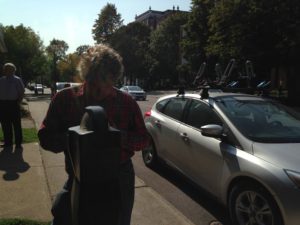 While traveling, we have started collecting 2 practical items: grocery store customer loyalty cards and parking apps. I collect the former, which usually involves going to the customer service desk and filling out a form. Chuck handles the latter, which usually requires a download. However, the Charlottetown parking app totally defeated him. After about half an hour, during which I did my banking and wandered around a bit, Chuck finally gave up. I wandered around some more looking for looneys (Canadian $1 coins) to put in the meter. Chuck probably thinks I am crazy for posting this photo, but we download parking apps in just about every city we visit.
While traveling, we have started collecting 2 practical items: grocery store customer loyalty cards and parking apps. I collect the former, which usually involves going to the customer service desk and filling out a form. Chuck handles the latter, which usually requires a download. However, the Charlottetown parking app totally defeated him. After about half an hour, during which I did my banking and wandered around a bit, Chuck finally gave up. I wandered around some more looking for looneys (Canadian $1 coins) to put in the meter. Chuck probably thinks I am crazy for posting this photo, but we download parking apps in just about every city we visit.
PEI is itself the birthplace of Canadian Confederation. In 1864 the Atlantic North American colonies of Britain (Nova Scotia, New Brunswick and PEI), faced with economic problems and the likelihood that the recently unemployed armies of the newly re-united USA would turn their attentions northward, held a conference in Charlottetown to discuss an alliance. This conference was crashed by delegates from Upper (Ontario) and Lower (Quebec) Canada who brought a lot of alcohol and a proposal for a broader union. After much partying and conferring, the group agreed to a confederacy. This agreement was sent to England for ratification, and as these things tend to do, took 3 years to pass. Canada became a dominion in 1867. Hence it is the 150th anniversary this year. Ironically, PEI decided it did not like the terms, and refused to join. However, in 1873 further pressures around the building of the Canadian National Railroad convinced PEI to join confederation. (Newfoundland did not join until 1949.) From Confederation Bridge to many commemorative signs in Charlottetown, PEI congratulates itself for its role in confederation (as indeed it should).
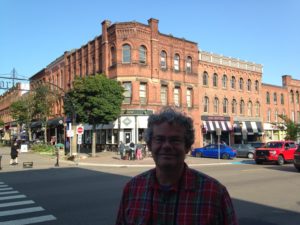
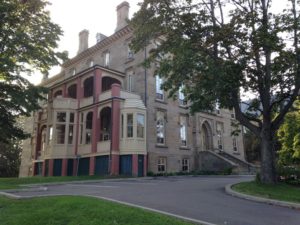 We found the Charlottetown pleasant, with a lot of older buildings and parks. One thing we liked were the sponsored street corner gardens. Various organizations can adopt street corners where they design and maintain a small garden. A lot of these were very lovely and most downtown intersections have one on each of the possible corners. This really beautifies the downtown.
We found the Charlottetown pleasant, with a lot of older buildings and parks. One thing we liked were the sponsored street corner gardens. Various organizations can adopt street corners where they design and maintain a small garden. A lot of these were very lovely and most downtown intersections have one on each of the possible corners. This really beautifies the downtown.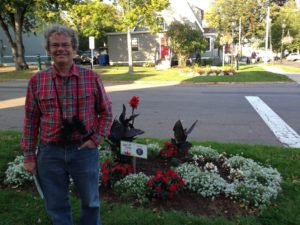
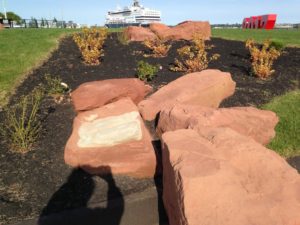 Charlottetown has a touristy harbor. I took this photo to show how red the sandstone is. The white patch is actually a natural greenish rock that occurs when the iron oxidizes in a different form.
Charlottetown has a touristy harbor. I took this photo to show how red the sandstone is. The white patch is actually a natural greenish rock that occurs when the iron oxidizes in a different form.
We stopped to take a photo at the 2017 sculpture to commemorate the 150th anniversary of confederation and to get some “Cow” ice cream. I liked the colorful aspect of these kayaks with the tourist Chinese junk behind.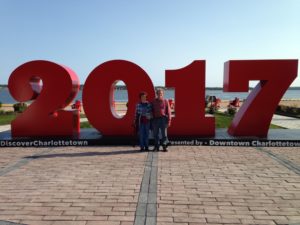
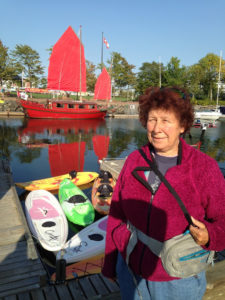
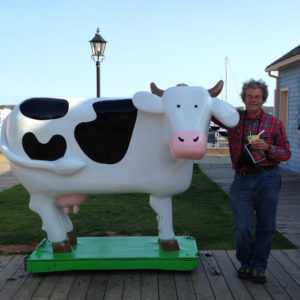
A highlight of our visit was the Northern Watters Knitwear and Tartan Shop. We initially went in because they had some nice men’s sweaters on display and I am still looking for yarn for Elisabeth’s poncho. However, we got to talking with the owner, and it was very interesting. The store uses yarn that is grown, dyed and spun in PEI, creating knitwear on 5 large knitting machines (which they call looms) in the back of the store. The owner was originally one of the loom operators. When the previous owners decided to close shop, she purchased the business, which is now thriving. They sell sweaters to 200 other shops both nationally and internationally, as well as other knitted goods done on the looms or by hand knitters. 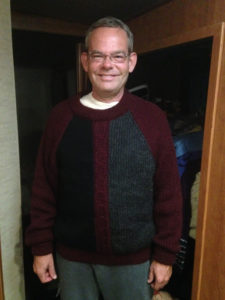 She told us she can make up a sweater in under 2 hours, and offered to make one up for Chuck if he did not like the colors already available.
She told us she can make up a sweater in under 2 hours, and offered to make one up for Chuck if he did not like the colors already available.
He bought the sweater in the photo which turned out to have a bit of a history, which she told us after Chuck selected. An elderly gentleman had become a very frequent customer, and she made this sweater for him, for delivery the next day. However, he passed away before sweater could be delivered. We share his color sense.
Before purchasing the shop, the owner and her husband bought an RV and used it on the weekends, often camping at our current campground on Rustico Bay. Now as the owner of a thriving business, she does not have time for recreation. She was bemoaning the retirement of her loom operators and wondering if she would be able to hire others. It turns out that she has been trying to hire one of our campground owners to do marketing for her. He currently has a day-job as marketer for a well-known international company.
Her husband runs a kilt store in the basement, so after Chuck bought a sweater upstairs, we went downstairs to have a look. We cannot imagine any occasion for which it would be appropriate for Chuck to wear a kilt. However, I have to admit that there is something very manly about some of the kilts (and men in kilts are actually pretty common in Nova Scotia). We also ended up having quite a chat with the saleslady in that store, who was working on finishing off one of the blankets from the knitwear shop and had just moved to PEI from Ontario.
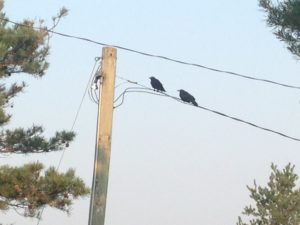 We meandered around town looking for some of the recommended dinner spots. It seemed to us that most of the recommendations had to do with the price of oysters, a delicacy we do not enjoy. Lobster is also popular, but not on our top-choice list. We ended up at a place with street seating right beside the sweater shop. As we sat down, a huge flock of crows appeared overhead — and crows kept coming for about 10 minutes. We already knew that PEI has a lot of crows, but this seemed very extraordinary – even for someone living in State College, where the university fires air guns to keep the flocks out of the main part of campus.
We meandered around town looking for some of the recommended dinner spots. It seemed to us that most of the recommendations had to do with the price of oysters, a delicacy we do not enjoy. Lobster is also popular, but not on our top-choice list. We ended up at a place with street seating right beside the sweater shop. As we sat down, a huge flock of crows appeared overhead — and crows kept coming for about 10 minutes. We already knew that PEI has a lot of crows, but this seemed very extraordinary – even for someone living in State College, where the university fires air guns to keep the flocks out of the main part of campus.
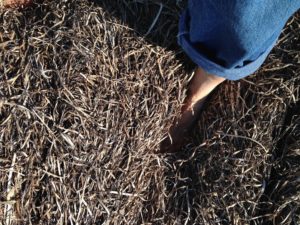 The next day we took the kayaks down to Rustico Bay. The shores of the bay are a foot or two deep with Irish moss, a type of seaweed (which looks like hay when dry, and is rather fleshy in the water). Irish moss is harvested for carrageen, a food thickener. Those are my feet ankle deep in dry Irish moss.
The next day we took the kayaks down to Rustico Bay. The shores of the bay are a foot or two deep with Irish moss, a type of seaweed (which looks like hay when dry, and is rather fleshy in the water). Irish moss is harvested for carrageen, a food thickener. Those are my feet ankle deep in dry Irish moss.
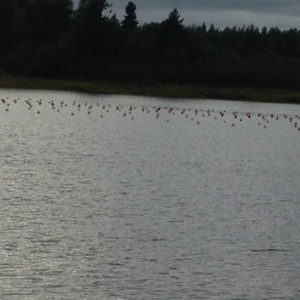 We were puzzled to see huge numbers of black buoys in the bay. We later learned that PEI now has a large shellfish farming industry – primarily mussels but also cultivated oysters.
We were puzzled to see huge numbers of black buoys in the bay. We later learned that PEI now has a large shellfish farming industry – primarily mussels but also cultivated oysters.
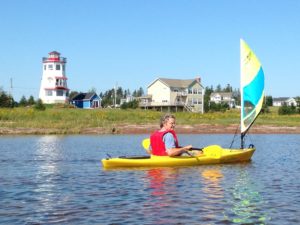
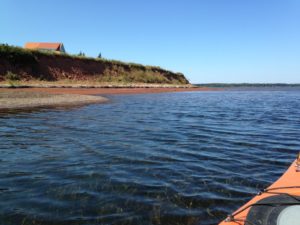 We took a long paddle along the far shore of the bay, and then crossed over to a spit of land that is part of the Prince Edward Island National Park. We had thought we could pull up on shore and cross the dunes to the Atlantic side. However, although it was fun walking through the springy dry Irish moss, once off the beach the dune vegetation was too thick to make progress. As well, although this put us on the same shore as the campground, the shoreline is very crenellated on that side, making it an even longer paddle back.
We took a long paddle along the far shore of the bay, and then crossed over to a spit of land that is part of the Prince Edward Island National Park. We had thought we could pull up on shore and cross the dunes to the Atlantic side. However, although it was fun walking through the springy dry Irish moss, once off the beach the dune vegetation was too thick to make progress. As well, although this put us on the same shore as the campground, the shoreline is very crenellated on that side, making it an even longer paddle back.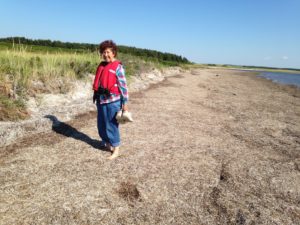 In the end, we went back the way we came and were satisfied with a very nice long paddle and a good view of the mussel farms.
In the end, we went back the way we came and were satisfied with a very nice long paddle and a good view of the mussel farms.
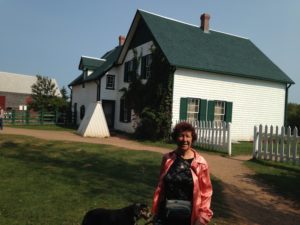 On Wednesday we went to Cavendish to see “Green Gables” which is also a National Park. (All National Parks in Canada are free this year to celebrate the 150th anniversary of Canada’s Confederation.) Love of “Anne of Green Gables” is a major reason why people visit PEI, and we met people from across the US and Canada as well as Britain and Japan.
On Wednesday we went to Cavendish to see “Green Gables” which is also a National Park. (All National Parks in Canada are free this year to celebrate the 150th anniversary of Canada’s Confederation.) Love of “Anne of Green Gables” is a major reason why people visit PEI, and we met people from across the US and Canada as well as Britain and Japan.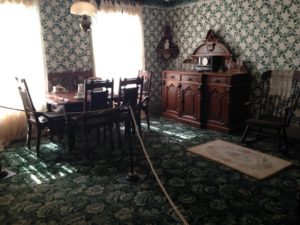 We started off a bit skeptical about Green Gables because, after all, “Anne of Green Gables” is a work of fiction. However, the author, L. M. Montgomery wrote in her diary that Green Gables was modeled after her Aunt and Uncle McNeil’s farm in Cavendish, and that all the places in the book are around the farm. The home and barn are the McNeil buildings, with the furnishings replaced by period pieces in keeping with Montgomery’s description in the book. It was a pleasant hike through “Lovers’ Lane” and the “Haunted Woods” and we enjoyed seeing the house and barn.
We started off a bit skeptical about Green Gables because, after all, “Anne of Green Gables” is a work of fiction. However, the author, L. M. Montgomery wrote in her diary that Green Gables was modeled after her Aunt and Uncle McNeil’s farm in Cavendish, and that all the places in the book are around the farm. The home and barn are the McNeil buildings, with the furnishings replaced by period pieces in keeping with Montgomery’s description in the book. It was a pleasant hike through “Lovers’ Lane” and the “Haunted Woods” and we enjoyed seeing the house and barn.
Despite the pervasiveness of Anne’s attraction and the huge number of tourists on the island, most of the touristy Anne things are in Cavendish itself. This is a good thing, as the charm of PEI is that it still looks a lot like it did in the early 1900s and has not been spoiled by the thriving tourism business. I think many people come for Anne but stay for the seafood, the trails and the ambience.
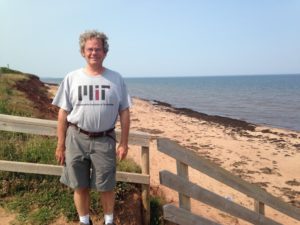
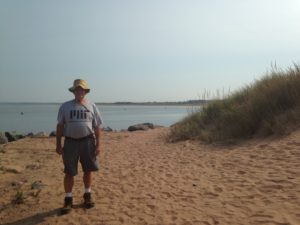 Following the very strong hints of the woman in the Tourist Information Office, we went into N. Rustico for lunch. We ate at a beachside restaurant, and then walked up the point to the town boardwalk, which was very scenic. We finished off the day by a trip to the local bakery, where we picked up a couple of meat pies, recommended by the same source. (We ended up eating these delicious meat pockets a couple of days later in the RV.)
Following the very strong hints of the woman in the Tourist Information Office, we went into N. Rustico for lunch. We ate at a beachside restaurant, and then walked up the point to the town boardwalk, which was very scenic. We finished off the day by a trip to the local bakery, where we picked up a couple of meat pies, recommended by the same source. (We ended up eating these delicious meat pockets a couple of days later in the RV.)
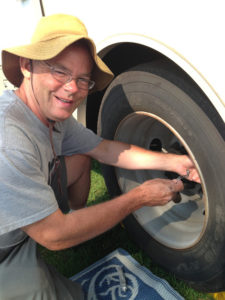 The next day, we spent some time on practical issues around the RV. The first thing was to install our tire pressure monitors on our 6 RV and 4 car tires. Chuck purchased these even before we left, but has been nervous about installng them, in case the installation led to leaks. However, his sister Karen had already successfully installed hers with no problems. After 2 flats on the car, both of which fortunately occurred when we were driving the car, and his parents’ problems getting their RV flat fixed,
The next day, we spent some time on practical issues around the RV. The first thing was to install our tire pressure monitors on our 6 RV and 4 car tires. Chuck purchased these even before we left, but has been nervous about installng them, in case the installation led to leaks. However, his sister Karen had already successfully installed hers with no problems. After 2 flats on the car, both of which fortunately occurred when we were driving the car, and his parents’ problems getting their RV flat fixed,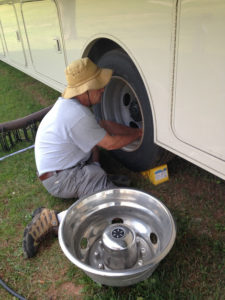 Chuck decided it was time to bite the bullet. The pressure monitors screw into the tire valve and communicate pressure and temperature wirelessly to a monitor. We had a slight leak after installation on one tire, but this was easily fixed by tightening the cap.
Chuck decided it was time to bite the bullet. The pressure monitors screw into the tire valve and communicate pressure and temperature wirelessly to a monitor. We had a slight leak after installation on one tire, but this was easily fixed by tightening the cap.
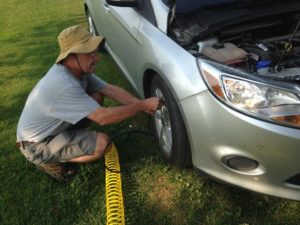
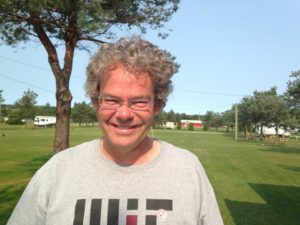 For some years, Elisabeth’s friend Brianna has been cutting Chuck’s hair. He bought a set of clippers so that she could achieve a more professional look, and brought these along so that I could cut his hair en route. Chuck knows the risks. I have given 2 previous haircuts. My college friend came out looking as if I had put a bowl an top of his head.
For some years, Elisabeth’s friend Brianna has been cutting Chuck’s hair. He bought a set of clippers so that she could achieve a more professional look, and brought these along so that I could cut his hair en route. Chuck knows the risks. I have given 2 previous haircuts. My college friend came out looking as if I had put a bowl an top of his head.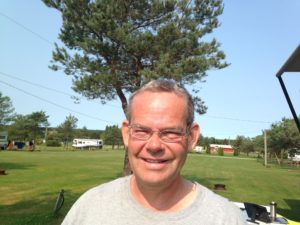 Elisabeth ended up with bangs that were about 1/4 inch long, and vowed never to let me near her again with scissors. However, with the clippers, it is really quite easy to do a short hair cut, and I think it came out OK. Here are the before and after pictures.
Elisabeth ended up with bangs that were about 1/4 inch long, and vowed never to let me near her again with scissors. However, with the clippers, it is really quite easy to do a short hair cut, and I think it came out OK. Here are the before and after pictures.
Since we did not do anything during the day, we decided to go to a ceilidh (Celtic music, pronounced kay-lee) in the evening. PEI has a very active Celtic music scene. The population is about 30% Irish and 30% Scottish, so there is a tradition of “kitchen parties” in which people bring their instruments and people socialize or dance. There is usually a “lunch” involved. Lunch is a snack, generally involving sandwiches. Lunch can be served at any time of day. (In PEI, the noon meal is dinner and th evening meal is supper.)
Apparently the music tradition was fading 30 years ago, but that is not true today. There is an on-line ceilidh calendar, and even though we were well out of the main tourist season, most nights there are 4 – 8 performance ceilidhs one can attend. We opted to go to one which included dinner at a nearby community center. I did not feel that we needed to be there as ridiculously early as Chuck suggested, it being after the main tourist season. Unfortunately, Chuck turned out to be correct, and we were turned away at the door due to lack of room.
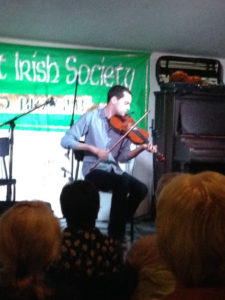
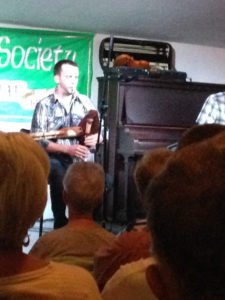 Undaunted, we headed to the Irish Benevolent Society in Charlotte-town, where we were able to get a seat. The organizers had
Undaunted, we headed to the Irish Benevolent Society in Charlotte-town, where we were able to get a seat. The organizers had
invited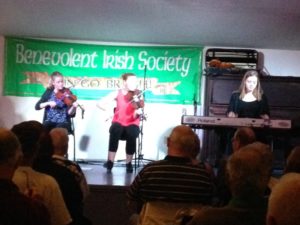 “new” musicians – a group of very young women who played fiddle and keyboards and also did Irish dancing, a young man who played bagpipes, and a young fiddler. All were very good. We had an opportunity to speak with other audience members and the musicians during the lunch break (around 9 p.m.).
“new” musicians – a group of very young women who played fiddle and keyboards and also did Irish dancing, a young man who played bagpipes, and a young fiddler. All were very good. We had an opportunity to speak with other audience members and the musicians during the lunch break (around 9 p.m.).
This is getting rather long, so I will break here and continue PEI in the next post.
